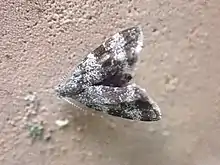Asterivora antigrapha
Asterivora antigrapha is a moth in the family Choreutidae.[1] It is endemic to New Zealand and has been observed in the North and South Island. This species inhabits the edge of scrubland. The adults are on the wing in November and December. This species can be found flying the day. It has been hypothesised that this species hibernates over winter.
| Asterivora antigrapha | |
|---|---|
 | |
| Scientific classification | |
| Kingdom: | |
| Phylum: | |
| Class: | |
| Order: | |
| Family: | |
| Genus: | |
| Species: | A. antigrapha |
| Binomial name | |
| Asterivora antigrapha | |
| Synonyms[2] | |
| |
Taxonomy
This species was first described by Edward Meyrick in 1911 using specimens collected at Kaitoke and Karori in December and March, and named Simaethis antigrapha.[3] In 1927 Alfred Philpott studied the male genitalia of this species.[4] George Hudson discussed and illustrated this species in his 1928 publication The butterflies and moths of New Zealand.[5] In 1979 J. S. Dugdale placed this species within the genus Asterivora.[6] In 1988 Dugdale confirmed this placement but pointed out that the lectotype and two paratypes were not in the Natural History Museum, London.[2] He stated that the specimens in the Natural History Museum, London were either dated November or 1910.[2]
Description
.jpg.webp)
The wingspan is 10–11 mm. The head and thorax are dark fuscous irrorated (speckled) with white. The antennae are dark fuscous dotted with white. The abdomen is dark fuscous, with a series of white scales on the segmental margins. The dark fuscous forewings are suboblong, moderate, the costa gently arched, the apex obtuse, the termen nearly straight and oblique. There is a basal patch and two irregular rather curved shades of purplish-white irroration almost wholly occupying the anterior half of the wing, the last running from a small white spot before the middle of the costa to the middle of the dorsum. There is also a small transverse-linear pale golden-metallic mark on the end of the cell. The dark fuscous hindwings are ovate-triangular, the termen is slightly rounded.[3]
Distribution
This species is endemic to New Zealand and has been observed in the North and South Islands.[1][7]
Habitat
This species can be found on the edge of scrubland.[5]
Behaviour
The adults of this species are in on the wing in November and December.[5] This species can be found flying the day.[5] Hudson stated that old specimens can be found in early spring and he hypothesised that this was as a result them hibernating over winter.[5]
References
- Gordon, Dennis P., ed. (2010). New Zealand inventory of biodiversity: Kingdom animalia : chaetognatha, ecdysozoa, ichnofossils. Vol. 2. p. 457. ISBN 978-1-877257-93-3. OCLC 973607714. OL 25288394M. Wikidata Q45922947.
- John Stewart Dugdale (23 September 1988). "Lepidoptera - annotated catalogue, and keys to family-group taxa". Fauna of New Zealand. Department of Scientific and Industrial Research. 14: 113. doi:10.7931/J2/FNZ.14. ISSN 0111-5383. Wikidata Q45083134.
- E. Meyrick (1 July 1911). "Notes and Descriptions of New Zealand Lepidoptera". Transactions and Proceedings of the New Zealand Institute. 43: 76. ISSN 1176-6158. Wikidata Q58200989.
- Alfred Philpott (15 November 1927). "The Male Genitalia of the New Zealand Glyphipterygidae". Transactions and Proceedings of the New Zealand Institute. 58: 337–347. ISSN 1176-6158. Wikidata Q110772020.
- George Vernon Hudson (1928), The butterflies and moths of New Zealand, Illustrator: George Hudson, Wellington, p. 309, LCCN 88133764, OCLC 25449322, Wikidata Q58593286
{{citation}}: CS1 maint: location missing publisher (link) - Dugdale, J. S. (1979-07-01). "A new generic name for the New Zealand species previously assigned to Simaethis auctorum (Lepidoptera: Choreutidae), with description of a new species". New Zealand Journal of Zoology. 6 (3): 461–466. doi:10.1080/03014223.1979.10428386. ISSN 0301-4223.
- "Asterivora antigrapha Meyrick, 1911". www.gbif.org. Retrieved 2022-02-01.